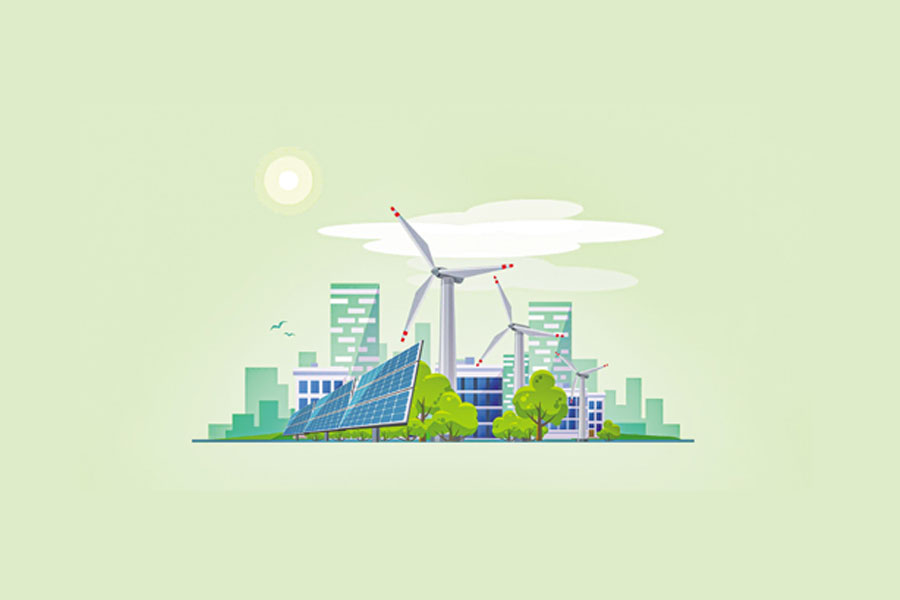
Published :
Updated :

Seventeen years after its first renewable energy framework done, Bangladesh has launched the Renewable Energy Policy 2025, aiming to generate 20 per cent of total electricity from renewable sources by 2030 and 30 per cent by 2040.
The policy marks a strategic pivot toward sustainable energy, aligned with national plans such as the Integrated Energy and Power Master Plan (IEPMP), Delta Plan 2100, and international climate commitments under the Paris Agreement.
The policy's vision is to decarbonize the energy sector, reduce reliance on fossil fuels, and foster a resilient, low-carbon economy. It outlines a roadmap for scaling up renewable energy (RE) technologies, attracting investment, and building institutional capacity to support the transition.
Key Features and Targets
The policy sets ambitious goals:
6,145 MW RE capacity by 2030
17,470 MW by 2041
It includes a diverse mix of RE sources: solar, wind, biomass, waste-to-energy, biofuels, geothermal, tidal, hydro, and green hydrogen. Solar dominates the current RE landscape, accounting for over 80 per cent of installed capacity, with 1,265 MW already in place.
To support these targets, the government has introduced:
10-year corporate tax exemptions for RE producers, followed by five years of partial relief
Import duty waivers on solar components
Peer-to-peer (P2P) energy trading frameworks
Net metering guidelines allowing rooftop solar installations to cover up to 100% of sanctioned load
The policy also promotes floating solar projects, solar irrigation, EV charging stations, and battery energy storage systems (BESS) to enhance grid integration and stability.
Institutional Roles and Regulatory Framework
The Sustainable and Renewable Energy Development Authority (SREDA) is designated as the nodal agency for:
Developing RE roadmaps and incentive structures
Introducing Renewable Energy Certificates (REC) and Renewable Purchase Obligations (RPO)
Overseeing quality control and research labs for RE equipment
The Bangladesh Energy Regulatory Commission (BERC) will license RE plants with capacities of 5 MW or more, determine tariffs, and ensure regulatory compliance.
Implementation Challenges
Despite its promise, experts warn that the policy may fall short without robust execution. Bangladesh's current RE capacity stands at 1,563 MW, or 5.6% of total electricity generation, far below the 10 per cent target set in the 2008 policy.
To meet the 2030 goal, the country must add 750 MW annually, a pace it has never achieved. Only 400 MW utility-scale projects are under construction, and foreign investment remains limited due to policy instability.
Recent shifts-such as the repeal of the Quick Enhancement of Electricity and Energy Supply Act (QEEESA) and suspension of over 30 RE projects-have dented investor confidence. The removal of payment guarantee clauses from tenders has made projects less bankable, leading to poor participation in bidding rounds.
Expert Opinions
Khondaker Golam Moazzem, Research Director at the Centre for Policy Dialogue (CPD), called the targets "ambitious and unfeasible." He criticized the lack of clarity around "green energy," noting that not all RE sources-such as biomass and large hydro-are environmentally benign.
Sharif Jamil, Member Secretary of Dhoritri Rokhhay Amra (DHORA), said the policy lacks specificity on priority technologies and fails to address the urgency of transitioning from imported fossil fuels.
Hasan Mehedi, Chief Executive of Coastal Livelihood and Environmental Action Network (CLEAN), argued that the policy is vague and disconnected from other national plans like the Mujib Climate Prosperity Plan and Nationally Determined Contributions (NDC). He emphasized the need for generation-based targets rather than installed capacity, and criticized the absence of a financing roadmap.
Shafiqul Alam, Lead Analyst at the Institute for Energy Economics and Financial Analysis (IEEFA), has stressed the importance of a time-based action plan and institutional strengthening. He noted that Bangladesh Bank's green refinancing scheme-expanded to Tk 10 billion-is still insufficient, with loans capped at Tk 300 million, far below the cost of a 10 MW solar park.
Kazi Ahsan Uddin, USAID energy expert, described the policy as a "potential game-changer" but warned that without institutional reform, budget prioritization, and cross-sector coordination, its transformative potential would remain unrealized.
Missed Opportunities and Sectoral Gaps
The policy offers generous incentives to corporate RE developers but excludes individual citizens. Rooftop solar adopters still face 26-56 per cent taxes on accessories, unlike countries like India and Cambodia, which offer up to 30 per cent direct subsidies.
The Ready-Made Garment (RMG) sector, which contributes over 80 per cent of Bangladesh's exports, has untapped potential. Most factories have installed only 5 kW systems, often to meet buyer requirements rather than sustainability goals. Challenges include land scarcity, high inverter costs, and limited access to green finance.
Land and Infrastructure
The policy encourages use of government khas land, char areas, riversides, and unused spaces owned by agencies like Bangladesh Railway, Roads and Highways Department, and Export Processing Zones (EPZs). It also supports agri-voltaic systems, allowing coexistence of farming and solar energy generation.
Looking Ahead
While the Renewable Energy Policy 2025 signals a bold shift, its success hinges on:
Stable policy environment
Clear implementation strategy
Investor-friendly regulations
Public-private partnerships
Capacity building at SREDA and other institutions
Bangladesh must also align its RE roadmap with broader climate and development goals, including the IEPMP, Delta Plan, and nationally determined contribution (NDC-3). Without these measures, the policy risks becoming another well-intentioned document that fails to deliver.
Azizjst@yahoo.com


 For all latest news, follow The Financial Express Google News channel.
For all latest news, follow The Financial Express Google News channel.